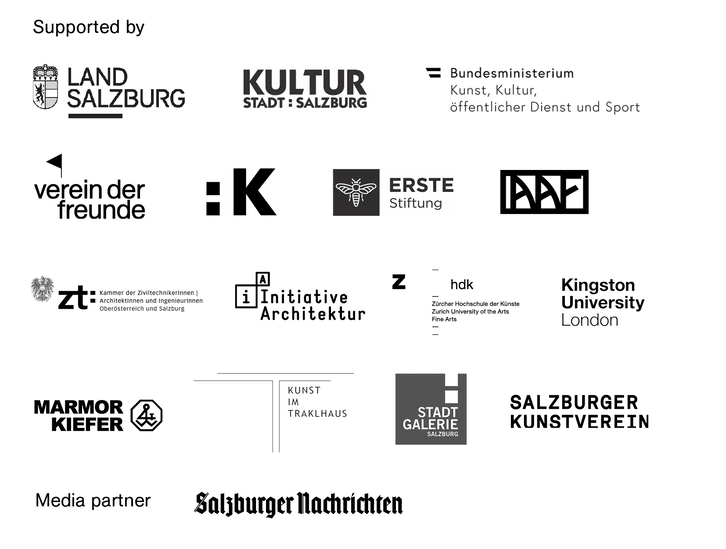| Shop |
- Academy
- Studies
- Courses
- – Courses 2024
- – All courses
- – Painting
- – Drawing
- – Printmaking
- – Photography / Film / Video
- – Sculpture
- – Installation
- – Performance
- – Architecture
- – Art Critique / Writing
- – Curating
- – Course archive 2023
- – Course archive 2022
- – Course archive 2021
- – Course archive 2020
- – Course archive 2019
- – Course archive 2018
- – Courses until 2017
- Events
- Blog/Videos
- Press
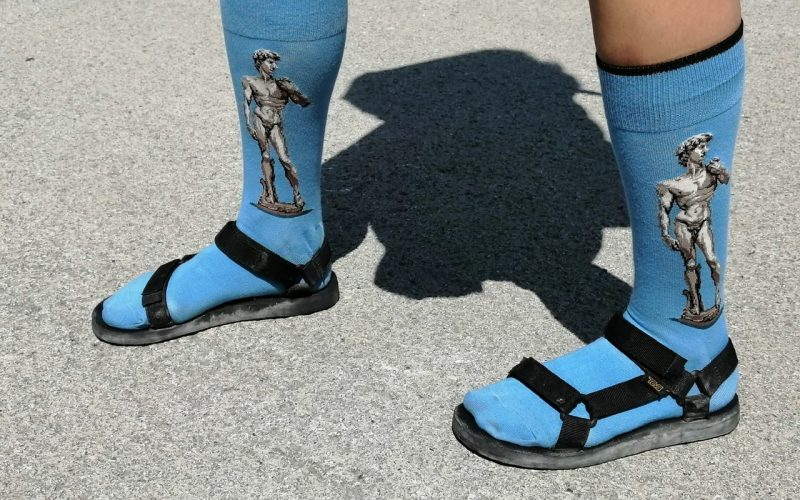
Michelangelo Socks — Rock ’n’ Roll Utopias
Karin Reichmuth describes cutting sculpture from stone as a process of reflection. Her course is entitled Listen to the stone. All the senses are enlisted to work an idea through the material. Her sculptures take dynamic forms. In this way, a dress’s fabric becomes marble, an inky octopus emerges from black stone and a propeller is fossilized mid-turn. “Stone wants to be touched” but “you have to think crucially about history before you touch the stone,”she states. For like painting, stone sculpture work is entrenched in history, patriarchy, and notions of craft.
Visiting the Summer Academy at the quarry at the address Kieferbruch 1— rough translation jaw-breaker— on the outskirts of Fürstenbrunn is in itself a remote adventure. Through a forest and up a steep hill with signs warning to slow down and no trespassing, the path opens up to a majestic rocky area, the working artists chiseling, hammering, flexing big machines on big stones. The quarry is where the limestone from the Untersberg mountain in pinks, yellow, white, red and frozen coral is resourced.
Here, Reichmuth’s students have created their community, sweating their creativity into their stones, eating and sleeping, dividing chores on site. Lunch is set like a people’s kitchen or a Judy Chicago banquet dinner table. Domestic labor is distributed equally and there is a plentiful supply of band-aids for working hands.
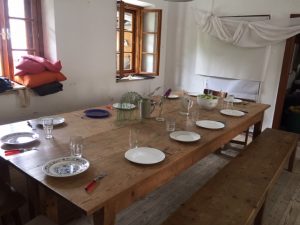
Most come to the class with an interdisciplinary background from film, performance, conceptual sculpture to pediatrics. Straight out of Charlotte Perkins Gilman’s sci-fi short story Herland, these artists have created a sustainable, feminist utopia in the most inclusive sense of the word. Everyone is welcome among the minerals, flora, and fauna, particular to the quarry environment. Wearing rock ’n’ roll T-Shirts, blue jeans and metals, they wield power tools. Stone is the common experience for all participants.

Fine dust settles on every part of the body. It’s like an analog FaceApp that shows you what you look like as you age, hair becomes white, the body exerts itself.
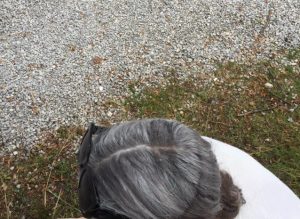
Sculpture vs. Stone Masons
Stonemasons have often been underappreciated in contemporary sculpture practices. In the same way that womyn have been underappreciated in sculpture and stone masonry. At contemporary art academies, traditional stone masonry has often been looked down on as too crafty or more of a trade than an art form. In the fine art world, the word “craft” is often used as a dirty word, though it is dependent on it. Without the blacksmith’s chisel, there would be no tools. However, these artists prove a shift towards material and process in the digital age. It is not outdated but updated.
What qualifies the fine art artist as more of an artist than the quarry worker or the foundry worker? Antonia Kuo, who works with lost-wax casting techniques in the U.S. when she is not in Salzburg hacking lime-stone, says she is wary of the fine artist, “It’s a question of intentions and the depth that defines stone as more than a nice object.” Elena Ailes comes from an interdisciplinary background in sculpture and is devoting herself to shaping a speech bubble. It relates to her research on material empathy. At this stage, her rock resembles a giant dinosaur egg or Anselm Kiefer’s sculpture of the Golem.
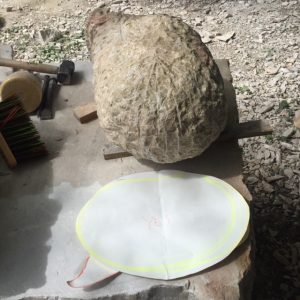
Giving a stone identity is a laborious process. The stone is the common denominator for each participant but each mineral is individual and each process requires subjective attention and a unique rhythm. Even before a stone meets its creator the stone must be handled, journeying from the mountain. Choosing your stone is also a very personal process. Each stone has a different ring to it. When the chisel hits the surface some have a glassy pitch and some have a deep, dull tone. This can already provide information about its carve-ability. Turning organic thoughts and feelings to firm shapes is a paradox but a worthy task. Egor Rogalov is carving an abstract shape, maybe a human brain. The relation of the process to the object reminds him of neuroplasticity. Anastasia Shneps-Shneppe is whittling two pinkish slabs into a supporting performative structure, based on her body building strength from a Chaturanga pose.
“I have to manifest these monuments,” Karin Reichsmuth says at her artist talk at the Galerie5020. Simone Rudolph, moderating asks, “Is it dangerous?” The answer, “You have to know the limits.” Overcoming the limits of control both physical, mental and geological is a big part of dealing with the quarry rocks. Sherine Anis and Mikkel Holm Torp, the co-teachers, help get things under control all day, splitting rocks and dealing with hairline cracks. Often stones have unforeseen internal fissures. The question to continue chiseling or give another rock a chance is highly existential.
Whether conscious or subconscious, gender is a crucial topic in the rock bed. Historically, female representation has predominately been in the form of busty muses. Those that wielded the methods of production were side-lined throughout art history, think Auguste Rodin vs. Camille Claudel. Therefore, giving a stone identity politics is inevitable. What was once a question is now an answer. Womyn and men in sculpture and stone cutting are a standard. Across the way, an army of figurative nudes, mostly female bodies, chiseled by mostly male artists silently watch Reichmuth’s class and rejoice. The Summer Academy’s squad shows the contemporary face of working artists in stone. Who is wearing the socks now, Michelangelo? They just do it.
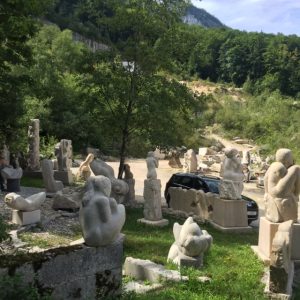
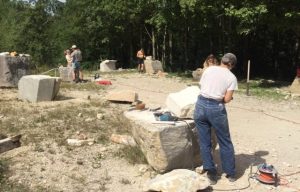
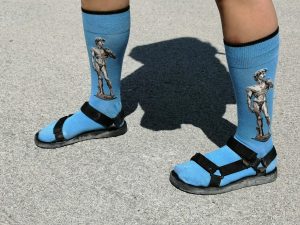
- 7 August 2019
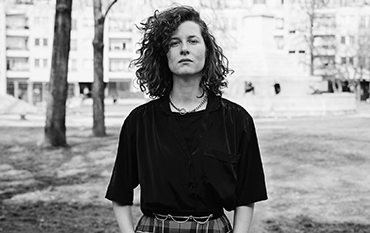
Authors
- Adelaide D' Esposito
- Albatross on the fortress
- Benedikt Breinbauer
- Chloe Stead
- Collaborative lecture performance
- Everything you always wanted to know about curating
- Gaia Tovaglia
- Hildegund Amanshauser
- Hili Perlson
- Karin Buchauer
- Montage my beautiful trouble
- Nina Prader
- Olamiju Fajemisin
- Processing our days
- Recently deleted
- Summer Academy
- Tex Rubinowitz
- Writing in on and through art
List by
Internationale
Sommerakademie
für bildende Kunst
Salzburg
T +43 662 842113
| Follow us: Newsletter TikTok YouTube |
| © 2023 / Imprint / Privacy Policy |
